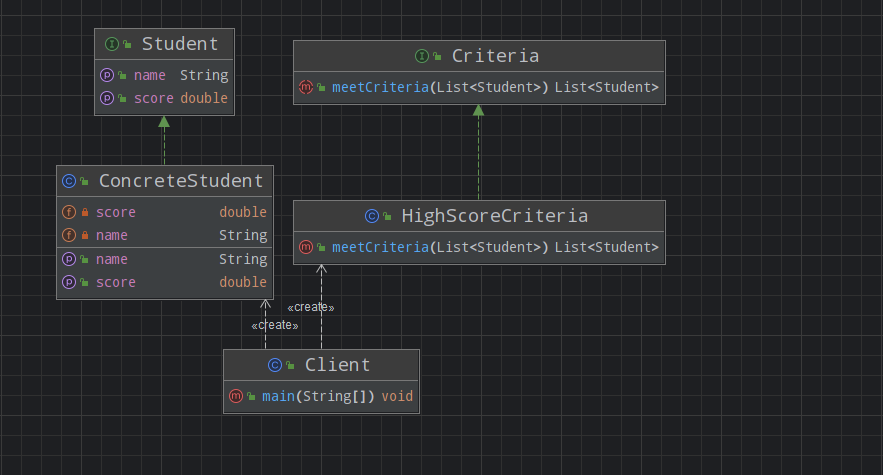过滤器模式
About 2 min
过滤器模式(Filter Pattern)允许开发人员通过逻辑条件对对象集合进行筛选操作,而不需要修改这些对象。这种模式属于行为型设计模式,通过提供一系列的过滤器来处理数据集,并根据需要选择合适的过滤器。

在过滤器模式中,主要包含以下角色:
- 目标接口(Target Interface): 这个接口定义了所有待过滤对象共享的方法,通常用于获取原始数据集。
- 具体目标类(Concrete Target): 实现目标接口的具体类,包含了要被过滤的数据集合。
- 过滤器接口(Filter Interface): 定义了一个抽象方法,该方法接受目标对象并可能返回一个经过过滤的新集合。每个过滤器都实现了这个接口。
- 具体过滤器类(Concrete Filter): 每个具体过滤器类实现过滤器接口,并定义了具体的过滤逻辑。它们可以链接起来形成过滤链,以便对数据进行多级过滤。
代码实现
有这么一个需求,我们希望将分数高于某个分数的学生筛选出来,这时候可以使用过滤器模式。
目标接口
目标接口暴露提供给过滤器使用的条件。
public interface Student {
double getScore();
String getName();
}
具体目标类
具体目标类中我们维护学生的姓名及分数。
public class ConcreteStudent implements Student {
private String name;
private double score;
public ConcreteStudent(String name, double score) {
this.name = name;
this.score = score;
}
@Override
public double getScore() {
return score;
}
@Override
public String getName() {
return name;
}
}
过滤器接口
过滤器接口接收所有学生的结合,通过子类实现过滤逻辑,返回满足条件的学生集合。
public interface Criteria {
List<Student> meetCriteria(List<Student> students);
}
具体过滤器类
具体过滤器中需要指定分数线,并按照这个参数对输入的集合进行过滤。
public class HighScoreCriteria implements Criteria {
private double passingScore;
public HighScoreCriteria(double passingScore) {
this.passingScore = passingScore;
}
@Override
public List<Student> meetCriteria(List<Student> students) {
List<Student> filteredStudents = new ArrayList<>();
for (Student student : students) {
if (student.getScore() >= passingScore) {
filteredStudents.add(student);
}
}
return filteredStudents;
}
}
使用
public class Client {
public static void main(String[] args) {
List<Student> students = Arrays.asList(
new ConcreteStudent("Alice", 90),
new ConcreteStudent("Bob", 85),
new ConcreteStudent("Charlie", 70)
);
Criteria highScoreFilter = new HighScoreCriteria(85);
List<Student> highScoringStudents = highScoreFilter.meetCriteria(students);
for (Student student : highScoringStudents) {
System.out.println(student.getName() + " 的分数为: " + student.getScore());
}
}
}
结果:






